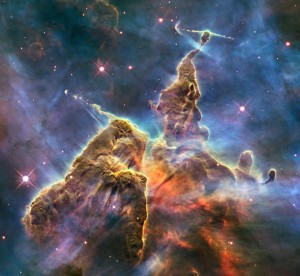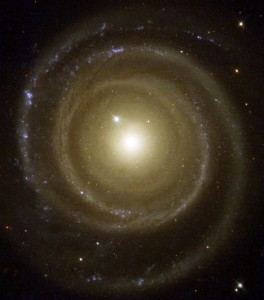The universe, our cosmology
The universe, a term that stems from the Latin word “universus” (“entire”) and from “unus” and “versus” (“combined into one”), is considered by science to be space and the entirety of things. Looking into the infinite distances of space is looking into the past and moves us to reverence. Nowhere else are space and time so unified as in the exploration of our universe. Nowhere else can we comprehend the development of matter and life, that is, the unification of the foundations of creation with the circles of creation and elements that arise from it. The cosmological foundations of space exploration are Einstein’s theory of relativity and description of the structure of our universe. The age of the universe has been estimated, on the basis of precise measurements by the WMAP satellite, at 13.7 billion years. The sun and the earth arose comparatively recently, about 4.6 billion years ago, from condensation points in a gas and dust cloud.
Was the Big Bang really the beginning?
Until the middle of the 20th century, steady-state theory, according to which space has always had the same structure, held sway. In 1964, the discovery of cosmic background radiation led to the popularization and recognition of the Big Bang Theory, which posits that the universe, as it is today, arose from a central event that released phenomenal amounts of energy. Previously, the cosmos had been extremely small, dense and hot, but subsequently, it has expanded constantly in all directions. The most recent measurements and calculations of the galaxies’ escape velocity revealed that this cosmic expansion began about 15 billion years ago. The Big Bang Theory also claims that time, space and matter have only existed since this primordial event. The question of origins and history was unfortunately thereby rendered irrelevant; there was no space in which anything could have happened according to this definition. But just as I was composing this section on creation, on March 18, 2014, cosmologists reported a ground-breaking discovery concerning the Big Bang Theory and the speed-of-light expansion of the universe. The Bicep2 microwave telescope received background radiation and gravity waves from space at the South Pole that have been shown to have their origin at the beginning of our worlds.
Two decisive insights have been obtained from this information:
1. The Big Bang Theory and its fundamental expansion is correct: the universe came into being within one billionth of a second after this primordial event.
2. This initial signal after the emergence of our universe clearly points to a multiverse. That means that in addition to ours, there is at least one other universe and perhaps many.
According to the Hermetic Principles, every effect has a cause, so any thinking person would ask who and what triggered this explosion and material creation and what happened before it? I am certain that it was the creator deity “on the other side”, in the spiritual universe. Astrophysicist Stephen Hawking once described the situation with an image of two worlds that are only separated from each other by a membrane. But we will begin by looking at our own universe, which is barely comprehensible to us in its expanse.
Galaxies and their solar systems
This incredible size only becomes imaginable to us when we turn to the galaxies that move through our universe. The term “galaxy” is used in astronomy to describe an island of worlds, a collection of matter bound together by gravity, consisting of stars, planetary systems, clouds of gas and dust and dark matter. Galaxies vary widely in terms of appearance, size and composition. They usually occur in groups or clusters of dozens or even thousands of individual galaxies; considered mathematically, there is an infinite number of them. The Hubble Telescope’s most recent “ultra-deep field” recordings from March 2004 allowed scientists to calculate that modern technology could be used to observe over 50 billion galaxies from the earth. That is probably an infinitesimal amount compared to the number existing in the entire universe.
When astronomers refer to “the galaxy” (in singular), they are always referring to our own galaxy, the Milky Way. On a clear night, the thickly clustered stars of our galactic disk resemble a trail of spilt milk, which is where the name comes from. With a diameter of 100,000 light years, it is one of the largest galaxies known to us and contains around 300 billion stars. The next-largest neighboring galaxy is Andromeda, 2.4-2.7 million light years away and together with other galaxies, we form a so-called small local group.
This is just a small excerpt from the book GAIA LEGACY.


